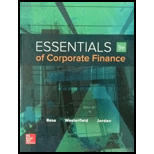
Essentials of Corporate Finance (Mcgraw-hill/Irwin Series in Finance, Insurance, and Real Estate)
9th Edition
ISBN: 9781259277214
Author: Stephen A. Ross Franco Modigliani Professor of Financial Economics Professor, Randolph W Westerfield Robert R. Dockson Deans Chair in Bus. Admin., Bradford D Jordan Professor
Publisher: McGraw-Hill Education
expand_more
expand_more
format_list_bulleted
Concept explainers
Textbook Question
Chapter 11, Problem 11.1C
What does variance measure?
Expert Solution & Answer
Summary Introduction
To discuss: The measures of variance.
Introduction:
Variance refers to the average difference of squared deviations of the actual data from the mean or expected return.
Explanation of Solution
The variance can measure two factors. They are as follows:
- The variances can measure on the spread of investment returns.
- This helps to determine the riskiness of returns of a security.
Conclusion
Variance is the sum of the difference of squared deviations of possible returns and the expected return multiplied by their respective probabilities.
Want to see more full solutions like this?
Subscribe now to access step-by-step solutions to millions of textbook problems written by subject matter experts!
Students have asked these similar questions
How can the budgeting process be used to reinforce (or fail to reinforce) public service goals? Provide an example of a local, state, or federal budget where funding allocations reflected policy priorities.
How do changes in working capital affect cash flow? Hrlp
I need correct answer
What does a current ratio below 1 indicate about a company's liquidity?
Chapter 11 Solutions
Essentials of Corporate Finance (Mcgraw-hill/Irwin Series in Finance, Insurance, and Real Estate)
Ch. 11.1 - How do we calculate the expected return on a...Ch. 11.1 - Prob. 11.1BCQCh. 11.2 - What is a portfolio weight?Ch. 11.2 - How do we calculate the expected return on a...Ch. 11.2 - Is there a simple relationship between the...Ch. 11.3 - Prob. 11.3ACQCh. 11.3 - Prob. 11.3BCQCh. 11.4 - Prob. 11.4ACQCh. 11.4 - Prob. 11.4BCQCh. 11.5 - Prob. 11.5ACQ
Ch. 11.5 - Prob. 11.5BCQCh. 11.5 - Prob. 11.5CCQCh. 11.5 - Prob. 11.5DCQCh. 11.6 - Prob. 11.6ACQCh. 11.6 - Prob. 11.6BCQCh. 11.6 - How do you calculate a portfolio beta?Ch. 11.6 - True or false: The expected return on a risky...Ch. 11.7 - Prob. 11.7ACQCh. 11.7 - Prob. 11.7BCQCh. 11.7 - Prob. 11.7CCQCh. 11.8 - If an investment has a positive NPV, would it plot...Ch. 11.8 - Prob. 11.8BCQCh. 11 - What does variance measure?Ch. 11 - Prob. 11.2CCh. 11 - What is the equation for total return?Ch. 11 - Prob. 11.4CCh. 11 - Prob. 11.5CCh. 11 - By definition, what is the beta of the average...Ch. 11 - Section 11.7What does the security market line...Ch. 11 - Diversifiable and Nondiversifiable Risks. In broad...Ch. 11 - Information and Market Returns. Suppose the...Ch. 11 - Systematic versus Unsystematic Risk. Classify the...Ch. 11 - Systematic versus Unsystematic Risk. Indicate...Ch. 11 - Prob. 5CTCRCh. 11 - Prob. 6CTCRCh. 11 - Prob. 7CTCRCh. 11 - Beta and CAPM. Is it possible that a risky asset...Ch. 11 - Prob. 9CTCRCh. 11 - Earnings and Stock Returns. As indicated by a...Ch. 11 - Determining Portfolio Weights. What are the...Ch. 11 - Portfolio Expected Return. You own a portfolio...Ch. 11 - Prob. 3QPCh. 11 - Prob. 4QPCh. 11 - Prob. 5QPCh. 11 - Prob. 6QPCh. 11 - Calculating Returns and Standard Deviations. Based...Ch. 11 - Prob. 8QPCh. 11 - Prob. 9QPCh. 11 - LO1, LO2 10.Returns and Standard Deviations....Ch. 11 - Calculating Portfolio Betas. You own a stock...Ch. 11 - Calculating Portfolio Betas. You own a portfolio...Ch. 11 - Using CAPM. A stock has a beta of 1.23, the...Ch. 11 - Using CAPM. A stock has an expected return of 11.4...Ch. 11 - Using CAPM. A stock has an expected return of 10.9...Ch. 11 - Prob. 16QPCh. 11 - Using CAPM. A stock has a beta of 1.23 and an...Ch. 11 - Using the SML. Asset W has an expected return of...Ch. 11 - Reward-to-Risk Ratios. Stock Y has a beta of 1.20...Ch. 11 - Prob. 20QPCh. 11 - Prob. 21QPCh. 11 - Prob. 22QPCh. 11 - Prob. 23QPCh. 11 - Calculating Portfolio Weights and Expected Return....Ch. 11 - Portfolio Returns and Deviations. Consider the...Ch. 11 - Prob. 26QPCh. 11 - Analyzing a Portfolio. You want to create a...Ch. 11 - Prob. 28QPCh. 11 - SML. Suppose you observe the following situation:...Ch. 11 - Systematic versus Unsystematic Risk. Consider the...Ch. 11 - Beta is often estimated by linear regression. A...
Knowledge Booster
Learn more about
Need a deep-dive on the concept behind this application? Look no further. Learn more about this topic, finance and related others by exploring similar questions and additional content below.Similar questions
- Dear expert need help. What factors can lead to a high price-to-earnings (P/E) ratio?arrow_forwardWhat is the 50/30/20 budgeting rule in finance , and how is it applied?dont use chatarrow_forwardI need help in this question What is the weighted average cost of capital (WACC) and why is it important?arrow_forward
arrow_back_ios
SEE MORE QUESTIONS
arrow_forward_ios
Recommended textbooks for you
- Principles of Accounting Volume 2AccountingISBN:9781947172609Author:OpenStaxPublisher:OpenStax College
 Managerial Accounting: The Cornerstone of Busines...AccountingISBN:9781337115773Author:Maryanne M. Mowen, Don R. Hansen, Dan L. HeitgerPublisher:Cengage Learning
Managerial Accounting: The Cornerstone of Busines...AccountingISBN:9781337115773Author:Maryanne M. Mowen, Don R. Hansen, Dan L. HeitgerPublisher:Cengage Learning Principles of Cost AccountingAccountingISBN:9781305087408Author:Edward J. Vanderbeck, Maria R. MitchellPublisher:Cengage Learning
Principles of Cost AccountingAccountingISBN:9781305087408Author:Edward J. Vanderbeck, Maria R. MitchellPublisher:Cengage Learning - Business Its Legal Ethical & Global EnvironmentAccountingISBN:9781305224414Author:JENNINGSPublisher:Cengage

Principles of Accounting Volume 2
Accounting
ISBN:9781947172609
Author:OpenStax
Publisher:OpenStax College

Managerial Accounting: The Cornerstone of Busines...
Accounting
ISBN:9781337115773
Author:Maryanne M. Mowen, Don R. Hansen, Dan L. Heitger
Publisher:Cengage Learning

Principles of Cost Accounting
Accounting
ISBN:9781305087408
Author:Edward J. Vanderbeck, Maria R. Mitchell
Publisher:Cengage Learning

Business Its Legal Ethical & Global Environment
Accounting
ISBN:9781305224414
Author:JENNINGS
Publisher:Cengage

Portfolio return, variance, standard deviation; Author: MyFinanceTeacher;https://www.youtube.com/watch?v=RWT0kx36vZE;License: Standard YouTube License, CC-BY